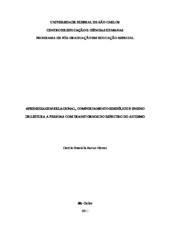| dc.contributor.author | Gomes, Camila Graciella Santos | |
| dc.date.accessioned | 2016-06-02T19:44:13Z | |
| dc.date.available | 2013-02-07 | |
| dc.date.available | 2016-06-02T19:44:13Z | |
| dc.date.issued | 2012-12-08 | |
| dc.identifier.citation | GOMES, Camila Graciella Santos. Relational learning, symbolic behavior and teaching reading to individuals with autism spectrum disorders. 2012. 199 f. Tese (Doutorado em Ciências Humanas) - Universidade Federal de São Carlos, São Carlos, 2012. | por |
| dc.identifier.uri | https://repositorio.ufscar.br/handle/ufscar/2903 | |
| dc.description.abstract | The overall aim of this thesis was to investigate relevant variables to relational learning and the emergence of symbolic behavior in people with autism, in the teaching of reading. Were conducted three studies that are independent and yet complementary. Chapter 1 describes a study that evaluated the performance of forty participants with autism and forty with intellectual disabilities in identity matching-to-sample task, in the typical organization (one model and three comparisons) and in the organization with more than one model (three models and three comparisons), in two forms of presentation that needed different response modes: on tabletop and by computer. The general results of the participants indicated better performance in the organization with more than one model, in paper and in computer. Chapter 2 presents a study that aimed to teach basic reading skills to five participants with autism (four speakers and one nonspeaker), from the teaching of arbitrary relations among pictures and printed words, using adapted matching-to-sample task. Participants learned basic reading skills, but not showed combinatorial reading. Chapter 3 presents a study designed to teach combinatorial reading with comprehension for three participants with autism, from the teaching of naming syllables, words, pictures, and the formation of stimulus equivalence classes. Participants learned combinatorial reading with comprehension, with few training sessions and low numbers of errors during the teaching. The set of studies indicate the possibility of symbolic learning by people with autism since appropriate teaching procedures are used. | eng |
| dc.description.sponsorship | Financiadora de Estudos e Projetos | |
| dc.format | application/pdf | por |
| dc.language | por | por |
| dc.publisher | Universidade Federal de São Carlos | por |
| dc.rights | Acesso Aberto | por |
| dc.subject | Educação especial | por |
| dc.subject | Autismo | por |
| dc.subject | Emparelhamento com modelo | por |
| dc.subject | Aprendizagem relacional | por |
| dc.subject | Leitura | por |
| dc.subject | Equivalência de estímulos | por |
| dc.subject | Comportamento simbólico | por |
| dc.subject | Leitura | por |
| dc.subject | Autism | eng |
| dc.subject | Matching-to-sample | eng |
| dc.subject | Relational learning | eng |
| dc.subject | Symbolic behavior | eng |
| dc.subject | Stimulus Equivalence | eng |
| dc.subject | Reading | eng |
| dc.subject | Special education | eng |
| dc.title | Aprendizagem relacional, comportamento simbólico e ensino de leitura a pessoas com transtornos do espectro do autismo | por |
| dc.title.alternative | Relational learning, symbolic behavior and teaching reading to individuals with autism spectrum disorders | eng |
| dc.type | Tese | por |
| dc.contributor.advisor1 | Souza, Deisy das Graças de | |
| dc.contributor.advisor1Lattes | http://lattes.cnpq.br/4404800720856419 | por |
| dc.description.resumo | O objetivo geral dessa tese foi investigar variáveis relevantes para a aprendizagem relacional e para a emergência de comportamento simbólico em pessoas com autismo, no âmbito do ensino de leitura. Foram realizados três estudos que são independes e ao mesmo tempo complementares. O Capitulo 1 descreve um estudo que avaliou o desempenho de quarenta participantes com autismo e quarenta com deficiência intelectual em tentativas de emparelhamento com modelo por identidade, na organização típica (um modelo e três comparações) e na multimodelo (três modelos e três comparações), em duas formas de apresentação que requeriam modos de resposta diferentes: em papel e por computador. Os dados gerais dos participantes indicaram melhores desempenhos nas tentativas multimodelo, em papel e no computador. O Capitulo 2 apresenta um estudo que pretendeu ensinar habilidades básicas de leitura a cinco participantes com autismo (quatro falantes e um não falante), a partir do ensino de relações arbitrárias entre figuras e palavras impressas, por meio de tentativas de emparelhamento com o modelo multimodelo. Os participantes aprenderam habilidades básicas e iniciais de leitura, porém não demonstraram leitura recombinativa com compreensão. O Capítulo 3 apresenta um estudo planejado para ensinar leitura combinatória com compreensão a três participantes com autismo, a partir do ensino da nomeação de sílabas, palavras, figuras e da formação de classes de estímulos equivalentes. Os participantes aprenderam leitura combinatória com compreensão, com poucas sessões de treino e com baixo número de erros durante o ensino. O conjunto de estudos indica a possibilidade da aprendizagem simbólica por pessoas com autismo desde que procedimentos de ensino adequados sejam utilizados. | por |
| dc.publisher.country | BR | por |
| dc.publisher.initials | UFSCar | por |
| dc.publisher.program | Programa de Pós-Graduação em Educação Especial - PPGEEs | por |
| dc.subject.cnpq | CIENCIAS HUMANAS::EDUCACAO::TOPICOS ESPECIFICOS DE EDUCACAO::EDUCACAO ESPECIAL | por |
| dc.contributor.authorlattes | http://lattes.cnpq.br/2060252495001734 | por |
